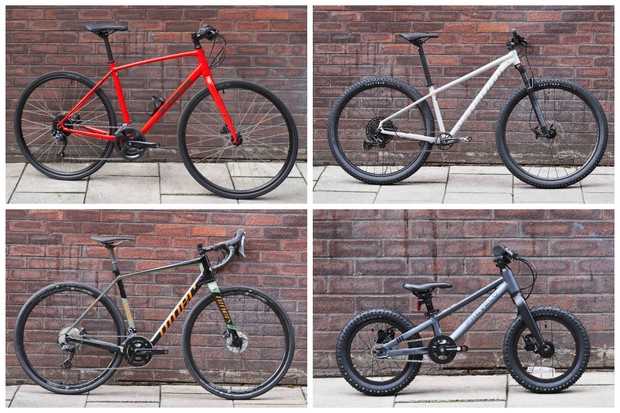
If you’re in the market for a new bicycle, it’s important to understand the different aspects of the design and model to make an informed decision. One of the key components to consider is the brakes. The type of brakes on a bicycle can greatly impact its performance and safety. Common types of brakes include rim brakes, disc brakes, and coaster brakes. Rim brakes are the most common and use friction to slow down or stop the bicycle. Disc brakes, on the other hand, use a rotor and caliper to squeeze the brake pads against the rotor. Coaster brakes are often found on children’s bicycles and are activated by pedaling backward.
Another important aspect of a bicycle is the saddle. The saddle, or seat, is where the rider sits and plays a crucial role in comfort and support. There are various types of saddles available, each with its own design and features. Some saddles are narrow and lightweight, ideal for racing or long-distance riding, while others are wider and more padded, providing extra cushioning for leisurely rides.
Gears are another essential feature to consider when choosing a bicycle. Gears allow riders to adjust the resistance and cadence of their pedaling, making it easier to climb hills or ride at higher speeds. Bicycles can have a range of gear options, from single-speed models to bikes with multiple gears. The number of gears will depend on the type of riding you plan to do and the terrain you’ll be encountering.
The frame of a bicycle is the backbone of its design and plays a significant role in its overall performance. Frames are typically made from materials such as aluminum, steel, carbon fiber, or titanium. Each material has its own unique properties, influencing factors such as weight, stiffness, and durability. Aluminum frames are popular for their lightweight nature, while steel frames offer durability and a smooth ride. Carbon fiber frames are known for their stiffness and responsiveness, while titanium frames provide a balance of strength and weight.
Lastly, the pedals are an important component of a bicycle. Pedals are where the rider’s feet make contact and provide the power to propel the bicycle forward. There are different types of pedals available, including platform pedals, clipless pedals, and toe clip pedals. Platform pedals are the most basic and provide a flat surface for the rider’s feet. Clipless pedals require special cycling shoes with cleats that attach to the pedal, providing a more secure connection. Toe clip pedals feature straps that secure the rider’s feet to the pedal, offering some degree of control and efficiency.
Contents
Understanding the basic components

When it comes to understanding the bicycle model, it is important to have a good grasp of the basic components that make up this popular mode of transportation. These components include the brakes, saddle, design, pedals, wheels, and frame.
Brakes: The brakes are an essential safety feature on a bicycle. They allow the rider to slow down or come to a complete stop when necessary. There are different types of brakes, including rim brakes and disc brakes, each with its own advantages and disadvantages.
Saddle: The saddle, also known as the bike seat, is where the rider sits. It is designed to provide comfort and support during long rides. The saddle can be adjusted to accommodate different body types and riding preferences.
Design: The design of a bicycle encompasses various aspects, such as the frame geometry, handlebar style, and overall aesthetics. The design of a bicycle can affect its performance, comfort, and suitability for different types of riding.
Pedals: The pedals are where the rider’s feet go. They are attached to the crank arms, which transfer the rider’s power to the drivetrain. Pedals come in different types, including platform pedals, clipless pedals, and toe clip pedals.
Wheels: The wheels are a crucial component of a bicycle. They provide stability, support the weight of the rider, and allow the bike to roll smoothly. Bicycle wheels are typically made of a rim, spokes, and a hub, and they come in various sizes and materials.
Frame: The frame is the backbone of a bicycle. It provides structural support and determines the overall strength, weight, and ride quality of the bike. Frames can be made of different materials, such as steel, aluminum, carbon fiber, or titanium, each with its own characteristics.
Understanding these basic components of a bicycle model is essential for anyone looking to delve deeper into the world of cycling. By familiarizing yourself with these key elements, you will be better equipped to make informed decisions when it comes to choosing the right bike for your needs and preferences.
Different types of bicycle models
There are various types of bicycle models available in the market today, each designed for specific purposes and preferences. These models differ in terms of their wheels, brakes, frame, gears, saddle, pedals, and overall design.
One common type of bicycle model is the road bike, which features thin tires and a lightweight frame. Road bikes are designed for speed and efficiency, making them ideal for long-distance rides on paved roads. They usually have drop handlebars that allow the rider to adopt an aerodynamic position.
Mountain bikes, on the other hand, are designed for off-road adventures. They have wider tires with deep treads for better traction on rough terrains. Mountain bikes also feature a sturdy frame and powerful brakes to handle the challenges of trails and downhill descents.
Hybrid bikes are a combination of road and mountain bikes. They feature a more upright riding position and wider tires compared to road bikes, making them suitable for both city commuting and light off-road trails.
For those looking for a leisurely ride, cruiser bikes are a popular choice. These bikes have a comfortable upright seating position, wide saddles, and often come with a basket or a rack for carrying belongings. Cruiser bikes are perfect for casual rides around the neighborhood or along the beach.
Folding bikes are compact and portable, making them convenient for urban commuters. They can be easily folded and stored in small spaces, such as under a desk or in the trunk of a car. Folding bikes usually have smaller wheels and a lightweight frame.
Lastly, electric bikes, also known as e-bikes, are gaining popularity. These bikes are equipped with a battery-powered motor that assists the rider’s pedaling, making it easier to tackle hills or cover longer distances. Electric bikes come in various styles, including road, mountain, and hybrid models.
| Type | Features |
|---|---|
| Road Bike | Thin tires, lightweight frame, drop handlebars |
| Mountain Bike | Wide tires, sturdy frame, powerful brakes |
| Hybrid Bike | Upright riding position, wider tires |
| Cruiser Bike | Comfortable seating position, wide saddle, basket/rack |
| Folding Bike | Compact, portable, smaller wheels |
| Electric Bike | Battery-powered motor, assisted pedaling |
Importance of choosing the right size

When it comes to buying a bicycle, choosing the right size is of utmost importance. The size of the bicycle affects your comfort, control, and overall riding experience.
Firstly, the right size ensures that you can pedal efficiently. If the bicycle is too big or too small, it can cause discomfort and strain on your knees and legs. This can lead to a decrease in pedaling power and make it harder to ride for long distances.
Secondly, the right size affects your control over the bicycle. A properly sized bicycle allows you to have a comfortable reach to the handlebars and brakes. This ensures that you can easily and safely operate the brakes and have full control over the bicycle, especially in emergency situations.
Furthermore, the right size affects the overall frame design and geometry. Different bicycle models have different frame designs, and the size of the bicycle determines the proportions and angles of the frame. Choosing the right size ensures that you are properly aligned with the bicycle’s geometry, providing a balanced and stable ride.
Additionally, the right size affects the size of the wheels and tires. Bicycles come in different wheel sizes, and the size of the bicycle determines the appropriate wheel size. Choosing the right size ensures that the wheels are properly aligned with the frame, providing optimal performance and handling.
Lastly, the right size affects the gearing of the bicycle. Bicycles come with different gear ratios, and the size of the bicycle determines the appropriate gear range. Choosing the right size ensures that you have the right gear range for your riding style and terrain, allowing you to pedal comfortably and efficiently.
In conclusion, choosing the right size bicycle is crucial for a comfortable, controlled, and enjoyable riding experience. It affects your pedaling efficiency, control, frame design, wheel size, and gearing. So, take the time to find the right size that suits your body type and riding style before making a purchase.
History of the Bicycle Model

The bicycle model has a long and fascinating history, with its origins dating back to the early 19th century. The first bicycles were simple and made entirely of wood, with a basic frame and no pedals. These early designs were propelled by the rider pushing their feet against the ground.
As the years went by, bicycle design evolved and became more sophisticated. The introduction of pedals in the 1860s revolutionized the way bicycles were ridden, allowing for faster speeds and greater efficiency. This innovation, along with the adoption of metal frames, paved the way for the modern bicycle we know today.
In the late 19th century, the invention of the chain drive system further improved the bicycle model. This allowed for the use of gears, which made it easier to navigate different terrains and ride up hills. The addition of brakes also made cycling safer and more controlled.
Over time, the bicycle model continued to evolve and adapt to the changing needs and preferences of riders. The introduction of pneumatic tires in the late 19th century improved comfort and traction, while the development of different frame geometries allowed for specialized models for various purposes, such as road racing, mountain biking, and commuting.
Today, bicycles come in a wide variety of designs, with different types of frames, gears, wheels, and pedals to suit every rider’s needs. Whether you’re a casual cyclist or a professional racer, there is a bicycle model out there for you.
Invention and early development

The invention and early development of the bicycle can be traced back to the early 19th century. The first bicycles were quite different from the modern ones we see today. They had a simple design, consisting of a basic frame with two wheels, a saddle, pedals, and no gears or brakes.
One of the earliest models of the bicycle was known as the “Draisine” or “running machine,” invented by Karl Drais in 1817. This early bicycle had a wooden frame, no pedals, and the rider had to use their feet to push themselves forward. The design of the Draisine laid the foundation for future bicycle models.
Over the years, inventors and engineers made several improvements to the bicycle. The addition of pedals in the 1860s revolutionized the way people rode bicycles. This new design allowed riders to propel themselves forward using their feet, making cycling a more efficient and enjoyable mode of transportation.
The introduction of gears in the late 19th century further enhanced the performance of bicycles. Gears allowed riders to adjust the resistance and speed of the bike, making it easier to climb hills or ride on different terrains.
Another significant development in the early years of the bicycle was the introduction of brakes. Early bicycles had no braking mechanism, and riders had to rely on their feet or other external means to stop. The invention of the brake system made cycling much safer and more controllable.
Overall, the invention and early development of the bicycle paved the way for the modern models we have today. From the basic frame and no gears or brakes, the bicycle has evolved into a sophisticated and efficient mode of transportation.
Evolution of bicycle designs

The bicycle has undergone numerous design changes throughout its history, evolving from its early prototypes to the modern models we know today. Each new model introduced innovative features and improvements, making the bicycle more efficient, comfortable, and versatile.
One of the key elements of bicycle design is the saddle, which has evolved to provide better support and comfort for riders. Early bicycle models had simple saddles made of leather or other materials, but modern designs incorporate ergonomic features and advanced materials to enhance rider comfort.
Another important aspect of bicycle design is the frame, which has evolved to become lighter, stronger, and more aerodynamic. Early bicycle frames were made of wood or iron, but advancements in materials, such as steel, aluminum, and carbon fiber, have allowed for the development of lighter and more rigid frames.
The evolution of bicycle designs also includes improvements in braking systems. Early models relied on simple spoon brakes, but modern bicycles are equipped with advanced braking technologies, such as rim brakes, disc brakes, and hydraulic systems, which provide better stopping power and control.
The design of pedals has also evolved over time. Early bicycles had flat pedals made of wood or metal, but modern models often feature clipless pedals, which allow riders to secure their feet to the pedals for better power transfer and efficiency.
Lastly, the incorporation of gears into bicycle design has greatly enhanced its versatility. Early bicycles had only one gear, but modern models offer a wide range of gear options, allowing riders to easily tackle various terrains and inclines.
In conclusion, the evolution of bicycle designs has led to significant improvements in comfort, performance, and functionality. From the simple and rudimentary models of the past to the sleek and advanced bicycles of today, each design iteration has contributed to making the bicycle a popular and efficient mode of transportation.
Impact of bicycles on transportation

The bicycle is a simple yet efficient mode of transportation that has had a significant impact on the way people travel. Its design, consisting of a saddle, frame, wheels, gears, brakes, and pedals, allows for easy maneuverability and control.
Bicycles have played a crucial role in improving transportation systems around the world. They provide an affordable and environmentally friendly alternative to cars and public transportation. With bicycles, individuals can easily navigate through traffic, bypassing congestion and saving time on their daily commute.
Furthermore, bicycles promote a healthier lifestyle by encouraging physical activity. Regular cycling helps improve cardiovascular health, build strength and endurance, and reduce the risk of obesity and other chronic diseases. In addition, cycling can be a fun and enjoyable way to explore the surroundings, making it a popular choice for recreational activities.
In urban areas, bicycles have proven to be an effective solution for last-mile transportation. They are compact, lightweight, and easily maneuverable, allowing riders to reach their destination quickly and conveniently. This is especially beneficial in crowded city centers where parking spaces are limited and traffic congestion is high.
Moreover, the use of bicycles can help reduce air pollution and carbon emissions. By choosing to cycle instead of driving a car, individuals contribute to improving air quality and reducing the impact of transportation on climate change. This has led to the implementation of bike-sharing programs and the creation of dedicated cycling lanes in many cities around the world.
In conclusion, bicycles have had a profound impact on transportation. Their design and functionality make them a versatile and practical mode of travel. From improving urban mobility to promoting a healthier lifestyle and reducing environmental impact, bicycles continue to play a vital role in shaping transportation systems worldwide.
Benefits of the Bicycle Model

The bicycle model offers numerous benefits for both leisure and transportation purposes. Here are some of the key advantages:
- Exercise: Riding a bicycle is an excellent form of exercise that helps to improve cardiovascular health, build muscle strength, and increase overall fitness. Pedaling the bicycle’s pedals engages the leg muscles and provides a low-impact workout.
- Eco-friendly: The bicycle model is an environmentally-friendly mode of transportation as it does not produce any harmful emissions. By choosing to ride a bicycle instead of driving a car, individuals can reduce their carbon footprint and contribute to a cleaner and greener environment.
- Cost-effective: Owning and maintaining a bicycle is much more affordable compared to owning a car. Bicycles do not require fuel, and the cost of maintenance is significantly lower. Additionally, bicycles are not subject to parking fees or toll charges, making them a cost-effective transportation option.
- Convenience: The bicycle’s compact design allows for easy maneuverability and navigation through traffic. Bicycles can access narrow pathways and shortcuts, providing a convenient means of transportation, especially in crowded urban areas.
- Improved health: Regular cycling helps to improve mental health by reducing stress and anxiety levels. It also promotes better sleep patterns and boosts overall mood and well-being. Cycling is a fun and enjoyable activity that can be incorporated into daily routines.
- Versatility: The bicycle model comes in various designs and styles to cater to different preferences and needs. Whether it’s a mountain bike with sturdy wheels and gears for off-road adventures or a sleek road bike for speed and endurance, there is a bicycle model for every type of rider.
- Accessibility: Bicycles provide a means of transportation that is accessible to people of all ages and fitness levels. From young children learning to ride their first bike to older adults maintaining an active lifestyle, the bicycle model offers a form of transportation that is inclusive and accessible to everyone.
With its many benefits, the bicycle model remains a popular choice for individuals seeking a sustainable, affordable, and healthy mode of transportation.
Health and fitness advantages

When it comes to health and fitness, riding a bicycle has numerous advantages. The bicycle model, with its gears and pedals, provides an excellent opportunity for physical activity. Cycling helps improve cardiovascular health, as it involves continuous movement of the legs and engages various muscle groups.
The design of the bicycle frame allows for a comfortable and ergonomic riding position, which helps prevent strain on the back and neck. The saddle, or seat, is designed to provide support and reduce pressure on sensitive areas. This promotes good posture and reduces the risk of back pain.
In addition to cardiovascular benefits and improved posture, cycling also strengthens the leg muscles, including the quadriceps, hamstrings, and calves. Regular cycling can help tone and define these muscles, leading to increased strength and endurance.
Furthermore, cycling is a low-impact exercise that puts minimal stress on the joints compared to activities like running. This makes it an excellent option for individuals with joint problems or those recovering from injuries.
Lastly, riding a bicycle requires the use of brakes, which helps improve coordination and reflexes. Constantly monitoring the road and using the brakes when needed enhances cognitive function and reaction time.
In conclusion, the bicycle model offers numerous health and fitness advantages. From cardiovascular benefits to improved posture and muscle strength, cycling is a great way to stay active and maintain a healthy lifestyle.
Environmental benefits

The bicycle model offers numerous environmental benefits. Firstly, the frame of the bicycle is typically made from lightweight materials such as aluminum or carbon fiber, which require less energy and resources to produce compared to other modes of transportation. This results in a lower carbon footprint and reduced emissions.
In addition, the wheels of a bicycle are designed to be efficient and require less energy to move compared to larger vehicles. This means that bicycles have a smaller impact on the environment and contribute to reducing air pollution.
The saddle and pedals of a bicycle are also designed with the environment in mind. They are typically made from sustainable materials and can be easily recycled at the end of their lifecycle. This reduces waste and conserves resources.
The gears of a bicycle model are designed to optimize energy efficiency. By allowing the rider to choose the appropriate gear for the terrain, less energy is wasted, resulting in a more sustainable mode of transportation.
Lastly, the brakes on a bicycle are typically designed to be energy-efficient and do not release harmful substances into the environment. This further reduces the environmental impact of using a bicycle model.
In conclusion, the bicycle model offers numerous environmental benefits due to its lightweight frame, efficient wheels, sustainable saddle and pedals, energy-efficient gears, and eco-friendly brakes. By choosing to use a bicycle as a mode of transportation, individuals can contribute to reducing their carbon footprint and promoting a more sustainable future.
Cost savings and economic advantages

Investing in a bicycle can lead to significant cost savings and economic advantages. Compared to other modes of transportation, such as cars or public transportation, bicycles are much more affordable to own and maintain.
One of the main areas where cost savings can be seen is in the maintenance of a bicycle. Unlike cars, bicycles have a much simpler design and fewer components that require regular servicing. The brakes, saddle, pedals, gears, frame, and wheels are some of the main parts that may occasionally need attention. However, the cost of maintaining these components is relatively low and can be done by the owner with basic tools and knowledge.
Furthermore, bicycles do not require fuel or electricity to operate, making them a cost-effective mode of transportation. With rising fuel prices and increasing concern for the environment, using a bicycle as a primary means of transportation can save individuals a significant amount of money in fuel costs. Additionally, bicycles do not require insurance, registration fees, or parking fees, further reducing the economic burden on the owner.
In terms of health benefits, cycling regularly can also lead to long-term cost savings. By incorporating cycling into a daily routine, individuals can improve their overall fitness and reduce the risk of developing various health conditions. This, in turn, can lead to lower healthcare costs and a higher quality of life.
In conclusion, the cost savings and economic advantages of owning a bicycle are undeniable. With minimal maintenance costs, no fuel or insurance expenses, and long-term health benefits, investing in a bicycle is a smart financial decision that can have a positive impact on both the individual and the environment.
Maintenance and Care for the Bicycle Model

Proper maintenance and care are essential for keeping your bicycle model in top condition. By following a regular maintenance routine, you can extend the lifespan of your bike and ensure optimal performance. Here are some key areas to focus on when it comes to maintaining and caring for your bicycle model:
| Component | Maintenance Tips |
|---|---|
| Frame | Regularly inspect the frame for any signs of damage or cracks. Clean the frame with a mild detergent and water, and dry it thoroughly to prevent rust. |
| Gears | Keep the gears clean and lubricated. Check for any wear and tear, and replace any worn-out components. Adjust the gears as needed for smooth shifting. |
| Saddle | Ensure that the saddle is properly adjusted to your comfort. Tighten any loose bolts and replace the saddle if it becomes worn or uncomfortable. |
| Brakes | Regularly inspect the brake pads for wear. Clean the braking surfaces and adjust the brakes for optimal performance. Replace any worn-out brake pads. |
| Pedals | Check the pedals for any signs of damage or looseness. Lubricate the pedal threads regularly and replace any worn-out pedals. |
| Bicycle Design | Consider the design of your bicycle model when performing maintenance. Some designs may require specific care or adjustments. Refer to the manufacturer’s guidelines for your specific model. |
Remember to always wear appropriate safety gear when working on your bicycle model. Regular maintenance and care will not only keep your bike in great condition but also enhance your riding experience.

Since childhood, I’ve been fascinated with vintage scooters and motorcycles. After university, I founded a workshop that restored classics like Vespas, Lambrettas, and MZs. With my girlfriend, Akiko Tanaka, I run the workshop’s website and showcase our custom restorations at iconic rallies across Europe and North America. Our Lambretta won first place at the 2019 Euro Lambretta meet in Germany. Through our website and global events, we share our passion for restoring and riding these retro rides.
